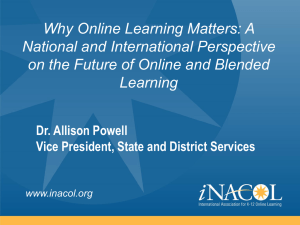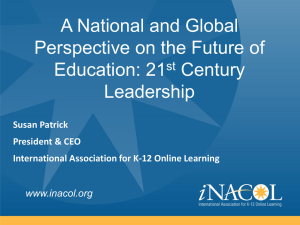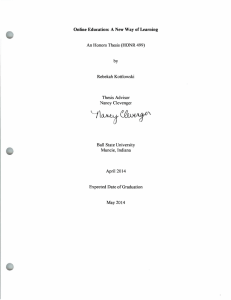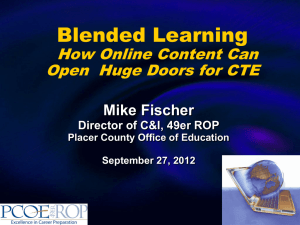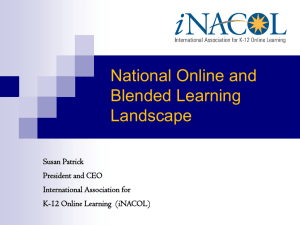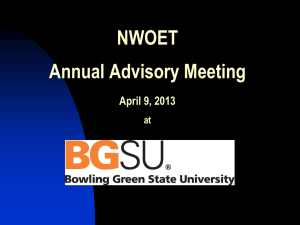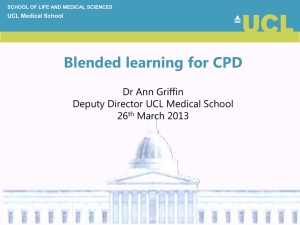Online Learning
advertisement
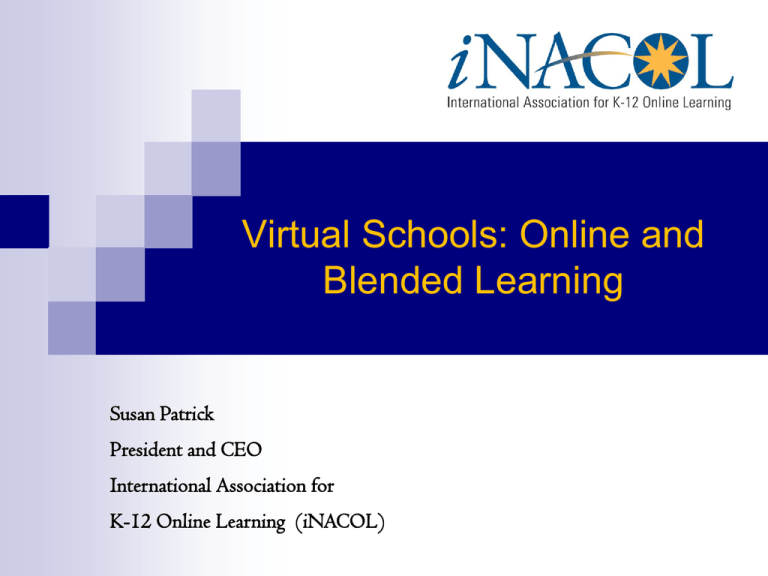
Virtual Schools: Online and Blended Learning Susan Patrick President and CEO International Association for K-12 Online Learning (iNACOL) Summary of key online learning activity Defining Dimensions of Online Programs Promising Practices: Case Studies Commonwealth Connections Academy, PA Cincinnati Public Schools VHS, OH Odyssey Charter Schools, Las Vegas, NV Chicago Virtual Charter School, IL Hoosier Academy, IN Kentucky Virtual School VOISE Academy, Chicago, IL Virtual Opportunities in a School Environment Community High School, Ann Arbor, MI Omaha Public Schools, NE Trends in K-12 Education: Next Generation Models of Online and Blended Learning •Buffet: F2F & Online Courses •Emporium: F2F place with blended/hybrid approaches to learning Hybrid/ Blended Programs Blended Courses •Online course and/or •Online content •Online instruction •LMS/Technology Online and Blended Course Definitions Allen & Seaman, 2007 Blended Learning: The Convergence of Online and Face-to-Face…the “Best of Both Worlds” • “Blended learning should be approached as not only a temporal construct, but rather as a fundamental redesign of the instructional model with the following characteristics: • -A shift from lecture- to student-centered instruction where students become interactive learners (this shift should apply to entire course, including face-to-face sessions); • -Increases in interaction between student-instructor, student-student, student-content, and student-outside resources; and • -Integrated formative and summative assessment mechanisms for student and instructor.” - Educause, Blended Learning (2004) Blended/Hybrid Learning “Combining face-to-face with fully online components optimizes both environments in ways impossible in other formats” Educause Research Bulletin, 2004 Digital content/curriculum, LMS, online assessments, data system, AI, simulations Shift in instructional model and PD/training Struggling student, low-engagement, (More direct student support needed) Self-direction, high engagement, (Less direct student support needed) Online Learning Research Highlights U.S. Department of Education study of Online Learning, “Evaluation of Evidence-based Practice in Online Learning: A Meta-Analysis and Review of Online Learning Studies” (2009) “Overall, the meta-analysis found that students who took all or part of their class online performed better, on average, than those taking the same course through traditional face-to-face instruction.” “instruction combining online learning with face-toface elements had a larger advantage . . .students the participated in online learning and who spent more time on task benefited the most.” Blended Learning: The Convergence of Online and Face-to-Face There is no single type of blended education; student-centered learning Policies: competency-based, multiple pathways New methods: content, assessment, collaborative development, PD, instruction/pedagogy New Platforms: Web-based platform; LMS New Solutions: Continuity of Learning H1N1 “Using the Internet to deliver courses seems to contain great disruptive potential. It could allow a radical transformation to happen in an incremental, rational way.” - Clayton Christensen, Harvard Business School Resources iNACOL Research Reports: At-Risk Students and Online Learning Access and Equity in K-12 Online Learning Professional Development for Virtual Schools iNACOL Promising Practices Series Blended Learning Credit Recovery and At-Risk Students Management and Administration of Online Programs Funding and Legislative Frameworks Identifying Needs of States for Online Courses and Services Needs Assessments Services Professional Development iNACOL conference: Virtual School Symposium Arizona, November 14-16, 2010 Monthly Webinars and Teacher Talk webinars National Quality Standards for K-12 Online Learning iNACOL National Standards of Quality for Online Courses iNACOL National Quality Standards for Online Teaching iNACOL National Quality Standards for Online Programs Questions? Susan Patrick, CEO, iNACOL Spatrick@inacol.org


